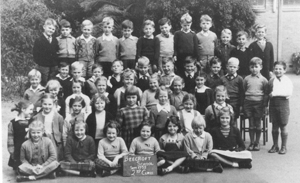Beecroft Public School[1]
The Beecroft Progress Association commenced petitioning for a public school to be built in 1891 but it was not until 1895 that the Under Secretary of Education considered that the population of children had grown sufficiently to warrant the building of a school. The brick school building able to house 60 students in the one classroom was opened on 27 March 1897 on the present site. Within 2 months there were 65 children enrolled and daily attendance was 59.

The first headmaster (1897-1902) Andrew Fuller saw the first extension to the school being built in 1898 and the construction of a headmaster’s residence on Beecroft Road. Despite this strong start, Mr Fuller had a number of charges of inappropriate discipline, he was declined for promotion and his assistant was removed for unsatisfactory work. Enrolments dropped to 18 in 1902-when he was forced to accept a transfer.
With the arrival of the second headmaster (1902-1924) James Forsyth, enrolments grew to 108 pupils. The single classroom designed for 60 must have been crowded. Mr Forsyth became actively involved in the community, encouraged the establishment of a Parents and Resident’s Association in 1907 and arranged many school excursions and picnics. These included the showing of over 4000 feet of film in a cinematograph entertainment in that same year.
There were then two short term headmasters, Hector James (1924-25), James Burrell (1925-28), prior to the arrival of Arthur Passmore (1928-1935). The school continued to expand in the size of its grounds and the number of buildings. Under each of these headmasters gardening and agriculture were strongly encouraged. School days commenced with the singing of ‘God Save the King” and in 1932 the flag was saluted on the first school date of each week. In 1935 Madeline Rubina Reid retired as a teacher after 25 years service at the school. A much loved teacher she was remembered by her students for her thoughtfulness and kindness for many decades.
Arthur Roy Davey was headmaster between 1935-43. He was a fiercely patriotic man remembered for reciting Australian verse and his work during both the Depression and the beginning of the Second World War. Air raid trenches were dug in the school grounds.
There was again a succession of short term headmasters: Walter C Ritchie (1943-47), Thomas Albertson (1947-52), James Loy (1952-54), and Leslie Snape (1955-1958). It was during the time of Mr Snape that a number of formal elements of school life came into being. One of the significant changes was the introduction of a school uniform in 1955 – of grey and white with a royal blue tie. The tradition of a Year 6 farewell organised by Year 5 commenced in 1957. In the same year Year 6 students commenced the first of the traditional annual trips to Canberra. Mr Snape was also both a member of the Executive of the NSW Teachers Federation but also President of the Headmaster’s Association of Sydney. Despite going on to other schools, he and his wife subsequently lived in Beecroft following his retirement.
During the time of Edgar Dill (1959-74) as headmaster major expansion and building work took place – including the building of the hall and a block of school rooms on the site of the headmaster’s residence. In part this expansion was in response to parents defying direction by the Education Department to enrol their children in other schools due to overcrowding at Beecroft. During this time classes were held in the School of Arts and the Anglican church hall. A recorder group was formed by the students which performed works by the local composer Nigel Butterley. In 1963 the motto of the school was changed from ‘Finem Rispice’ to ‘In knowledge we grow.’ The new motto was suggested by Roslyn McBurney in a competition.
Wilbur Reginald Raward (1975-1984) saw significant changes in syllabus, the growth of teaching aids and local action resulting in the installation of traffic lights. Headmasters Reginald Becker (1985-88), Thomas Hal Fredericks (1989-97) saw the continued growth of a number of programs and (especially under the guide of David Ellyard) of music as an important part of school life.

